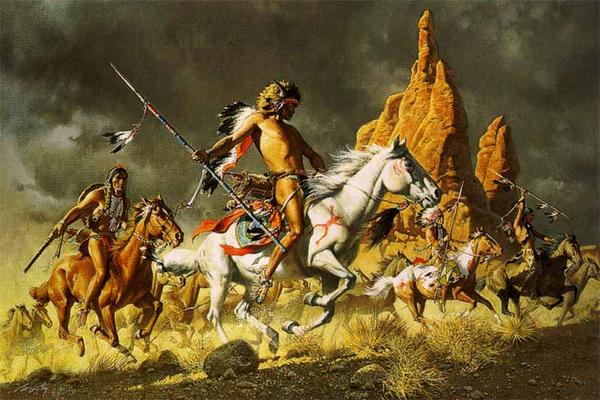
Comanchería: The Rise and Fall of the Comanche Empire is the second game in Joel Toppen’s “First Nations” series. Like its predecessor Navajo Wars, Comanchería is a solitaire game in which the player plays from the Native American tribe’s point of view.
In Comanchería, the player takes command of the Comanche nation. The player must drive hostile tribes from the southern plains, establish dominance over the region, set up trade networks with both friendly tribes and colonial powers, and finally defend all of this against relentless military and cultural attack.
While many mechanics will feel similar to Navajo Wars, Comanchería is a very different game and promises to deliver all the tough decisions and drama that Navajo Wars players have come to expect, but with a faster playing time and more streamlined victory objectives.
I want to thank Joel for his time in granting me this interview. I follow Joel on Twitter at @PastorJoelT and love to watch his unboxing videos and reviews of games that I normally would not even know about such as recently I watched him open the Battle of Rosebud Creek by Legion Wargames. I have now decided that I have to have it and have added it to my lengthy and growing wish list. So without further ado, onto the interview:
Grant: Tell us about your experience in dame design/development and which of those games you’ve been involved with are you most proud of?
Joel: I have no design background prior to Navajo Wars. I got into developing with GMT’s Hellenes project (Craig Besinque’s design). I’ve also developed Washington’s War, Labyrinth: The War on Terror, Andean Abyss, and Labyrinth: The Awakening for GMT Games. I also developed Storming the Reich for Compass Games. Navajo Wars was my first attempt at designing a game. Comanchería is my second attempt at game design. I’m probably most proud of Labyrinth by GMT Games.
Grant: We love Labyrinth and have played numerous times. Great work on that gem! What was your favorite game of your two to design and why?
Joel: Navajo Wars was more fun to design than Comanchería. Not sure why. Perhaps with Comanchería I felt/feel a lot of pressure to make it an even better game. The design work felt more like work.
Grant: What has been your biggest challenge with design? How have you overcome that problem?
Joel: The biggest challenge for me is marrying the “fun factor” with history. I want the game to be a serious representation of history but be fun to play at the same time. I think with both game designs I overcame the problem by designing mechanics that immerse the player into the history’s “story.”
Grant: How have you made the various enemies feel different in the game? Are there specific differences in the gameplay of the Spanish, Mexican and American soldiers and settlers?
Joel: In Navajo Wars I used the Instruction counters to govern enemy behavior in a way that approximates that enemy’s historical behavior. The gameplay of the Spanish, Mexican, and American soldiers and settlers is governed by a common set of rules. What makes them different is provided by the sets of “instruction counters” that come into play during each historic period in which these colonial factions were prevalent. Instruction counters drive the enemy AI in the game. They tell the enemy what to do and how to go about doing it.
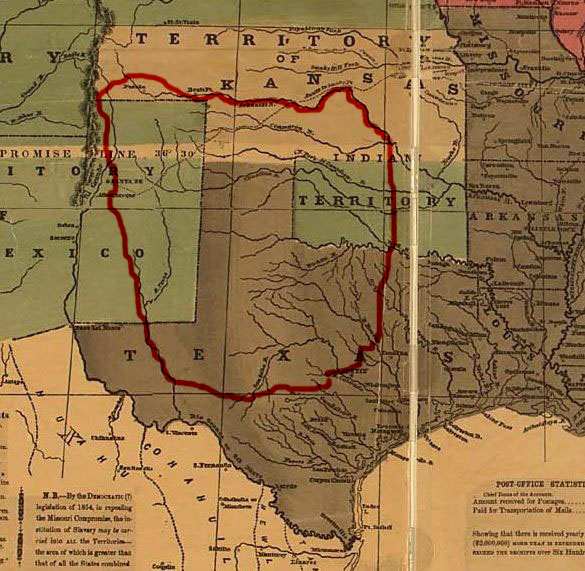
Grant: What challenges are there in designing a solo game?
Joel: Way more than you would imagine! For one, making sure playtesters are playing the game correctly — that they understand the rules. This is more challenging than you would think, especially when unique game mechanics are introduced in the design.
Grant: What is the two player version like? What is significantly different between the solo and 2 player versions?
Joel: It’s semi-cooperative. Both players share the decision-making for the tribe. Mechanically, there’s only a couple new concepts than in the solitaire game. Both players can lose, but only one player can win.
Grant: What would you change in the design if you could?
Joel: The victory check mechanism. I feel that the victory check mechanism in Navajo Wars is inelegant. It works, and it works well, but it isn’t nearly as streamlined as in Comanchería in my opinion.
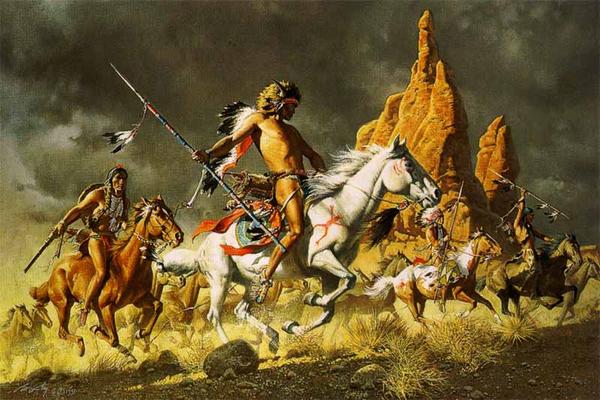
Grant: Why have you been drawn to design games focused on Native Americans?
Joel: I have lived most of my life among Native Americans. For over 22 years I lived among the Navajo. Currently I am serving on the Blackfeet Reservation in northwestern Montana.
Grant: Tell us about your new game Comanchería. It is also a solitaire game but how does it differ from Navajo Wars? What specifically did you modify in the main game engine?
Joel: The player controls the initiative and will gradually lose the initiative. Also, the AI has been modified. I believe the new Enemy Instruction mechanism to be more robust. It now governs the general behavior of four enemies. In conjunction with this, I’ve introduced History Cards that help to govern the overall activity of up to four different enemies.

Grant: How are the Comanche different from the Navajo? Was this challenging to capture in your design? Why?
Joel: The Comanche were more warlike. They fought and won a war of conquest over the sedentary tribes of what is now west Texas, Oklahoma, and Kansas. This primary difference meant that I had to design a different game model than that used in Navajo Wars.
Grant: What new mechanics have been introduced?
Joel: It would be easier to say what isn’t new! I’ve preserved the core of the Enemy Instruction Display and the core of the Cultural Development Cards concepts from Navajo Wars, but everything else is new.
Grant: How do you go about integrating theme into your game design? What stands out as a theme focused mechanic?
Joel: I think the Cultural Development cards are a key way that theme gets integrated into the design. Cultural Development cards bring Native American culture into the game in a way that is similar to technology trees in civilization games.
Grant: I love the maps. Do you draw the maps?
Joel: I drew the playtest maps. Donal Hegarty is the final map artist.
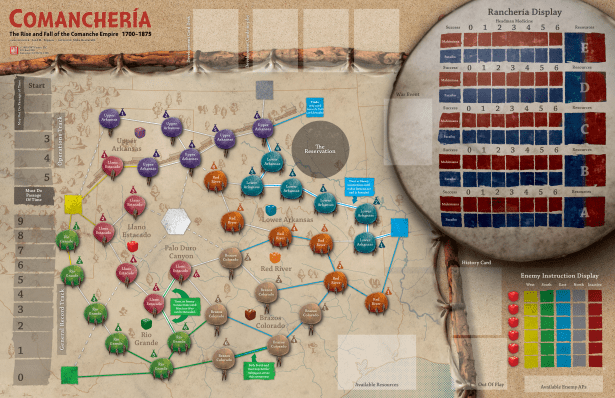
Grant: When can we expect to see Comanchería finished and released?
Joel: Everything has recently gone to the printers so soon.
Grant: Comanchería currently has over 900 orders on P500. How does that feel?
Joel: I’m very happy with the response!
Grant: What First Nations game is next? I have always been fascinated with the Nez Perce and their great leader Chief Joseph. Any thoughts on how you would design a game for them?
Joel: I am currently working on a Nez Perce game. That’s all I’ll say for now though. I’m also working on a game about the Lakota (Sioux).
Grant: What struggles have there been with staying true to history? Do you feel you have succeeded?
Joel: As I said earlier, there’s always a tension between modeling history and making the game fun to play. I believe I am succeeding with this.
Grant: What is it like working with GMT Games and Gene?
Joel: They’re awesome folks to work with! I consider myself blessed to be a part of the GMT family.
Grant: Do you ever see a possibility of a COIN connection for a First Nations themed game? There are many conflicts that would work. What about Crazy Horse and Sitting Bull? Or Geronimo?
Joel: The COIN model has done amazing things and works well in a number of situations. It modeled Native Americans fairly well in Liberty or Death.
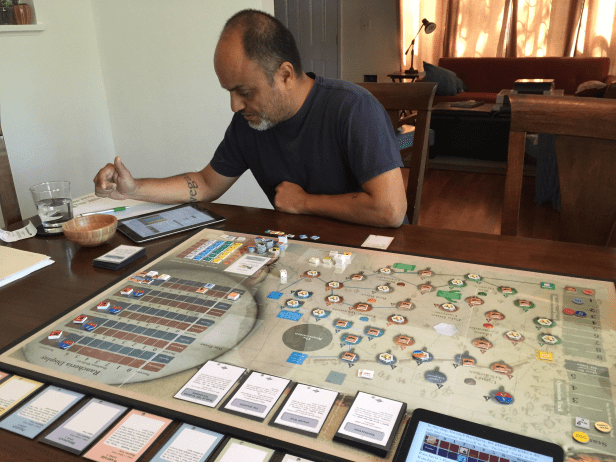
Thanks for the great interview Joel! We are all excited to see and play Comanchería as well as future games from you. For more information about the development of Comanchería check out the Designers Blog website: https://sites.google.com/site/comancheriadevelopment/designer-s-blog/comanchewarfarepart1weapons
-Grant
